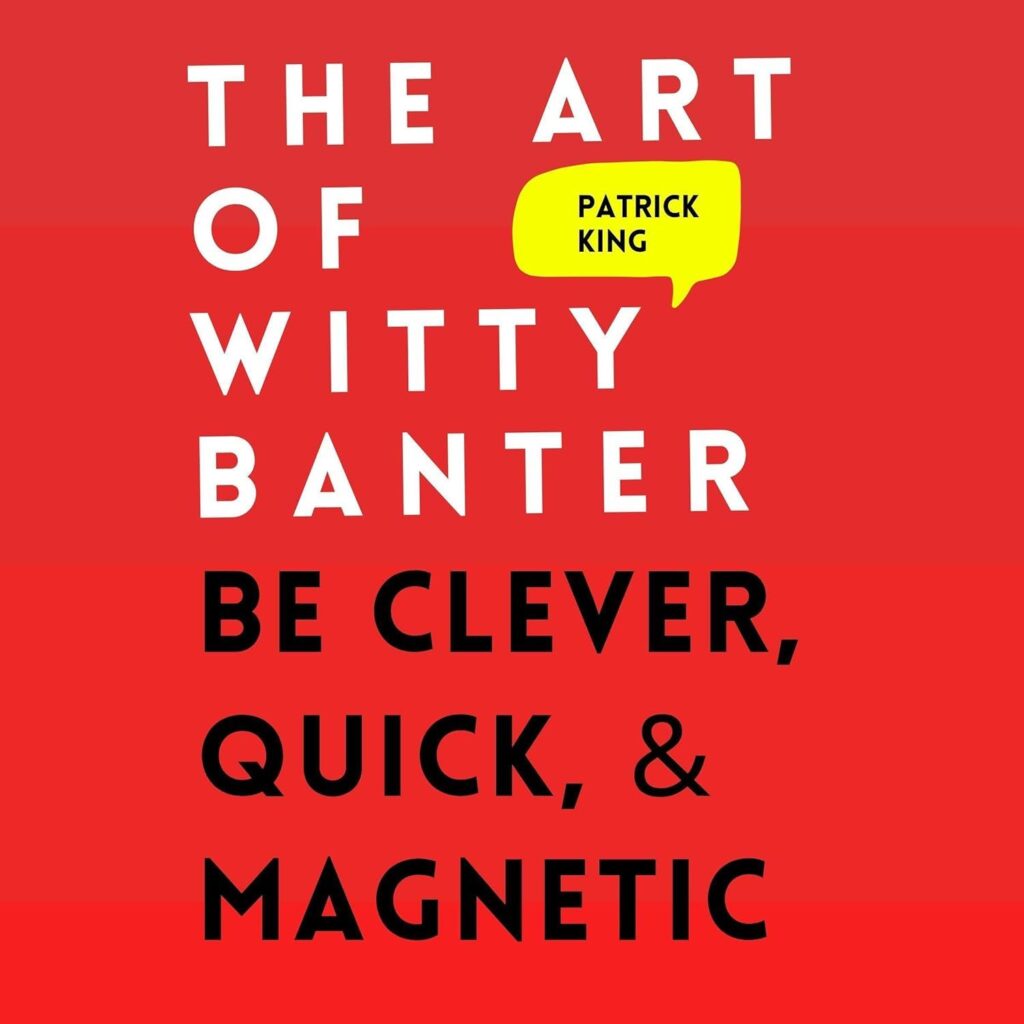Introduction to The Art of Witty Banter Summary

Have you ever found yourself in a conversation, feeling the awkward silence stretch just a little too long, wishing you could say something clever or funny but nothing comes to mind? You’re not alone. Most of us struggle with small talk, unsure how to keep it light, engaging, and memorable.
The Art of Witty Banter is more than just a guide to clever one-liners it’s a roadmap to transforming everyday interactions into playful, confident exchanges. Whether you’re meeting someone new, chatting with friends, or networking professionally, this book teaches you how to listen, respond, and inject humor in ways that feel natural and authentic.
Packed with practical examples, simple strategies, and easy-to-apply tips, it helps you uncover the witty, charismatic side of yourself that’s been waiting to shine. By the end, you’ll not only enjoy conversations more you’ll create connections that leave people smiling, laughing, and wanting more.
Why Witty Banter Matters
Conversations are more than just exchanging words; they’re the bridge to connection, trust, and influence. Witty banter adds charm and a playful edge to conversations. It makes people laugh, feel comfortable, and see you as someone worth talking to again. Without it, interactions can feel dull, awkward, or forgettable.
The Art of Witty Banter summary highlights one central truth: you don’t need to be a natural comedian to shine in conversation. Instead, it’s about mindset, timing, and a few repeatable techniques anyone can practice.
Key Lessons from The Art of Witty Banter

Here are the most important takeaways from the book:
1. Embrace Playfulness
At its core, banter is play. It’s not about putting others down or trying too hard; it’s about enjoying the interaction and creating a shared moment of fun. By approaching conversations with curiosity and a light-hearted spirit, you instantly become more engaging.
2. Master the Power of Comebacks
A witty comeback doesn’t need to be mean spirited. Instead, it should be clever, unexpected, and delivered with warmth. For example, if someone teases you lightly, responding with a humorous twist rather than defensiveness shows confidence and charm.
3. Ask Smart, Open-Ended Questions
One of the most underrated tools in witty banter is the art of asking questions that invite playful responses. Instead of “Did you like the movie?” try “If you could rewrite the ending of that movie, what wild twist would you add?” This sparks creativity and keeps the conversation flowing.
4. Use Exaggeration for Humor
Exaggeration is a simple, safe, and effective way to make your conversations more fun. For example, if a friend says they’re tired, you might say, “Tired? You look like you just fought off a dragon before breakfast.”
5. Practice Active Listening
Great banter doesn’t happen when you’re thinking too much about what to say next. It happens when you genuinely listen, pick up on small details, and respond creatively. This makes your comments feel personal, not rehearsed.
Mastering the Flow of Witty Banter
Imagine being able to think on your feet smooth, clever, and funny all at once. No more awkward silences, only confident conversational flow. Witty banter isn’t just about being entertaining; it’s a powerful tool that allows you to disarm tension, connect with people instantly, and transform small talk into meaningful, memorable exchanges.
In The Art of Witty Banter, Patrick King breaks down the mechanics of banter into clear, actionable steps. With his guidance, you’ll learn how to handle conversations like a pro whether it’s deflecting a tease, delivering a sharp comeback, or playfully steering dialogue in new directions. The result? You’ll not only feel more confident but also leave a lasting impression on everyone you meet.
This book shows you how to:
Use teasing, quick comebacks, and humor to build instant rapport.
Ask the right kinds of questions that keep people engaged instead of freezing them up.
Deliver compliments that land well and avoid the common mistakes people make.
Develop “fallback stories” to save any conversation from running dry.
Apply free association techniques to sharpen your wit and spontaneity.
Patrick King, an internationally bestselling author and social skills coach, makes witty banter approachable for anyone. He provides not just theory, but real-world examples and ready-to-use phrases you can apply in your daily life. Whether you want to shine at work, deepen friendships, or spark chemistry in romantic situations, this book is a practical roadmap to never being boring, awkward, or forgettable again.
As King explains, conversation is the foundation of success your career, your friendships, even your romantic life all grow from your ability to connect with others. By mastering witty banter, you’ll find yourself making sharper impressions, building stronger bonds, and enjoying a social life filled with laughter and connection.
Read also the book summary: The Let Them Theory
How to Apply These Lessons in Real Life

At work: Witty banter can make you stand out in meetings, interviews, or networking events. It shows quick thinking and social intelligence.
On dates: Playful banter builds attraction and creates chemistry faster than serious conversation alone.
With friends and family: Adding humor keeps relationships lighthearted and enjoyable.
By practicing the skills outlined in The Art of Witty Banter summary, you’ll notice that people naturally gravitate toward you because your conversations feel fun, confident, and refreshing.
Common Myths About Witty Banter
Many people think witty banter is only for extroverts or natural comedians. That’s not true. The book emphasizes that anyone can learn it through practice. Another misconception is that banter has to be sarcastic or cutting. In reality, the most effective witty banter is playful, inclusive, and respectful it makes everyone feel good.
My Personal Reflection
When I first came across The Art of Witty Banter, I realized how often I held back in conversations, afraid of saying something silly. This book shifted my mindset. It taught me that humor doesn’t have to be perfect it just has to be genuine. Once I gave myself permission to play with words, ask curious questions, and exaggerate lightly, conversations became more enjoyable for both me and the people I was talking to.
The biggest lesson? Banter isn’t about impressing others it’s about connecting with them in a memorable way.
About the Author – Patrick King

Patrick King is a Social Interaction Specialist and Conversation Coach based in San Francisco, California. He has dedicated his career to helping people improve their communication skills, build confidence, and master the art of engaging conversations.
Patrick’s expertise has been featured in prestigious outlets such as GQ Magazine, TEDx, Forbes, NBC News, Huffington Post, Business Insider, Men’s Fitness, Inc., ATTN, Real Simple Magazine, and CreativeLive.
Beyond coaching, Patrick is a multifaceted personality when he’s not helping clients conquer the world, he can be found fronting an 80’s cover band or training for his next 10k race.
For more insights, tools, and practical resources, visit his website: www.patrickingconsulting.com, where you can access The Flawless Interaction Checklist and The Better Conversations Worksheet for free, along with his other writings.
Ready to Transform Your Conversations?
If The Art of Witty Banter sounds like the guide you’ve been waiting for to make conversations fun and effortless, don’t wait any longer. This book is a practical companion that will help you unlock your playful, confident self step by step.
Whether you enjoy reading a physical copy, diving into your Kindle, or listening on the go through Audible, you can grab your copy today and start transforming the way you interact with others.
Take the first step today your witty, confident self is just one click away!
How Witty Banter Can Transform Your Daily Life
Think about the last time a conversation felt awkward. Imagine if you could turn that tension into laughter and connection. Witty banter breaks the invisible walls between people, making networking, family dinners, or casual chats more enjoyable and memorable.
It’s not just about sounding clever it’s about confidence and approachability. The more you practice, the more natural humor and playfulness flow in your interactions. Even small steps, like exaggerating a comment or asking a playful question, can ripple into stronger relationships and more enjoyable daily moments.
Final Thoughts on The Art of Witty Banter Summary
We’ve all had those moments where small talk feels awkward, or we walk away wishing we’d said something clever. This book reminds us that witty banter isn’t about memorizing jokes or forcing humor it’s about being present, playful, and authentic.
What I love most is how simple the strategies are. With a little practice, you’ll notice yourself listening better, responding with more confidence, and enjoying conversations instead of overthinking them. It’s not about becoming someone else it’s about uncovering the fun, confident version of you that’s already there.
So, next time you’re chatting with a friend, colleague, or even a stranger, try one of the techniques. Listen, exaggerate a little, or just play along. You might be surprised at how quickly the conversation feels lighter, more natural, and more fun.
That’s the beauty of witty banter it doesn’t just make you sound clever, it makes connection effortless.
Frequently Asked Questions (FAQ)
1. Is this book suitable for beginners in personal development?
Yes! Written in an engaging and simple style, it’s perfect even if you’re just starting your journey in self-improvement and social skills.
2. Should I read the book or listen to the audiobook?
It depends on your preference. The audiobook is ideal for on-the-go learning, while the physical or Kindle edition lets you highlight and take notes.
3. How long does it take to finish reading this book?
On average, most readers can complete it in about 6–8 hours. The audiobook usually takes around the same time, depending on the narrator’s pace.
4. Where can I buy the book?
Purchase it easily on Amazon or listen on Audible—both options are available in multiple formats.
5. Will this book really help me change my conversations?
The book provides practical strategies and insights, but real improvement comes from applying them consistently in your daily interactions.
